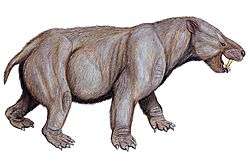Titanoides
| Titanoides Temporal range: Late Paleocene, 59–56 Ma | |
|---|---|
 | |
| Fossil | |
| Scientific classification | |
| Kingdom: | Animalia |
| Phylum: | Chordata |
| Class: | Mammalia |
| Order: | †Cimolesta |
| Suborder: | †Pantodonta |
| Family: | †Titanoideidae |
| Genus: | †Titanoides Gidley, 1917 |
| Type species | |
| †Titanoides primaevus Gidley, 1917 | |
| Species[1] | |
| |
Titanoides is an extinct genus of pantodont mammal that lived in North Dakota. They were up to 3 m (9.8 ft) long and up to 150 kg (330 lb) in weight, being the largest mammals of their habitat, a tropical swampland where the main predators were crocodiles. They had a bear-like appearance with huge canines and short limbs with five clawed digits even though they were herbivores.[2][3]
References
- ↑ "Pantodonta". After McKenna & Bell (1997) and Alroy (2002). Retrieved 2 November 2013.
- ↑ https://www.dmr.nd.gov/ndfossil/poster/PDF/Titanoides.pdf
- ↑ http://www.paleocene-mammals.de/large_herbivores.htm
External links
- "Ferae Past and Present (Phylogenetic tree)" at Okapiland
This article is issued from Wikipedia - version of the 6/29/2016. The text is available under the Creative Commons Attribution/Share Alike but additional terms may apply for the media files.